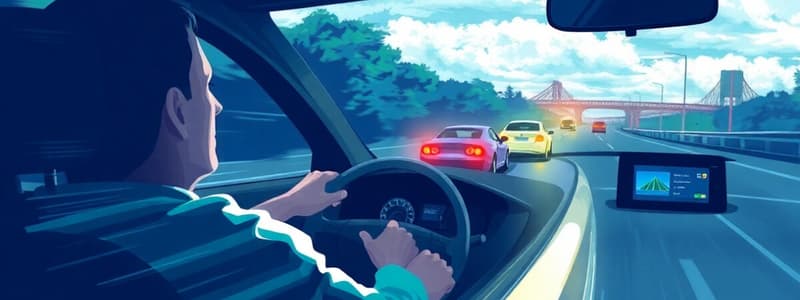Podcast
Questions and Answers
What is a key critique of skills models in traffic psychology?
What is a key critique of skills models in traffic psychology?
- They do not consider reaction time.
- They do not focus on driver perception.
- They only consider visual attributes.
- They are too simplistic and overlook other important factors. (correct)
According to attitude theories, which component represents what an individual believes others think about their behavior?
According to attitude theories, which component represents what an individual believes others think about their behavior?
- Intention
- Subjective norm (correct)
- Attitude
- Perceived control
Which aspect of the Theory of Planned Behavior (TPB) states how much control a person believes they have over their actions?
Which aspect of the Theory of Planned Behavior (TPB) states how much control a person believes they have over their actions?
- Perceived control (correct)
- Behavior
- Intention
- Attitude
What percentage of observed behavior does the Theory of Planned Behavior (TPB) predict, according to the critiques?
What percentage of observed behavior does the Theory of Planned Behavior (TPB) predict, according to the critiques?
In the context of traffic psychology, what does the term 'intention' specifically refer to?
In the context of traffic psychology, what does the term 'intention' specifically refer to?
Why is there often a weak link between attitudes and behavior in drivers, according to Rothengatter?
Why is there often a weak link between attitudes and behavior in drivers, according to Rothengatter?
Which of the following factors is NOT part of the components defined by attitude theories?
Which of the following factors is NOT part of the components defined by attitude theories?
What primarily influences crashes according to skills models?
What primarily influences crashes according to skills models?
What does the Risk Homeostasis Theory suggest about safety measures?
What does the Risk Homeostasis Theory suggest about safety measures?
Which of the following best describes the concept of 'homo economicus' in utility theories?
Which of the following best describes the concept of 'homo economicus' in utility theories?
How does Peltzman’s Driving Intensity theory relate to decision-making in traffic?
How does Peltzman’s Driving Intensity theory relate to decision-making in traffic?
What does Risk Allostasis Theory propose?
What does Risk Allostasis Theory propose?
What factor does the Risk Homeostasis Theory consider when assessing behavior changes?
What factor does the Risk Homeostasis Theory consider when assessing behavior changes?
According to Risk Homeostasis Theory, what can result from the introduction of winter tires?
According to Risk Homeostasis Theory, what can result from the introduction of winter tires?
What is a limitation of the Risk Homeostasis Theory?
What is a limitation of the Risk Homeostasis Theory?
Which theory suggests that individuals offset safety benefits by adopting riskier behaviors?
Which theory suggests that individuals offset safety benefits by adopting riskier behaviors?
What is a key aspect of the Multiple Comfort Zone Model?
What is a key aspect of the Multiple Comfort Zone Model?
What is the main critique regarding the Risk Monitor Model?
What is the main critique regarding the Risk Monitor Model?
What does the Multiple Comfort Zone Model emphasize in terms of goal achievement?
What does the Multiple Comfort Zone Model emphasize in terms of goal achievement?
What factor does NOT contribute to the establishment of safety margins in driving according to the Multiple Comfort Zone Model?
What factor does NOT contribute to the establishment of safety margins in driving according to the Multiple Comfort Zone Model?
How do some studies challenge the concepts proposed by the Multiple Comfort Zone Model?
How do some studies challenge the concepts proposed by the Multiple Comfort Zone Model?
What historical view about machines and driving is discussed?
What historical view about machines and driving is discussed?
What does the concept of 'safety margins' refer to in the context of driving behavior?
What does the concept of 'safety margins' refer to in the context of driving behavior?
In the context of the critiques noted in the models, what is a concern regarding learning complexities?
In the context of the critiques noted in the models, what is a concern regarding learning complexities?
What happens when the demand of a task exceeds the capacity of the operator?
What happens when the demand of a task exceeds the capacity of the operator?
Which factor does NOT affect the availability of resources for an operator?
Which factor does NOT affect the availability of resources for an operator?
What is the relationship between task complexity and processing stages?
What is the relationship between task complexity and processing stages?
How can mental workload be assessed effectively?
How can mental workload be assessed effectively?
Which of the following represents a temporary factor affecting an operator's capacity?
Which of the following represents a temporary factor affecting an operator's capacity?
What does the barrel metaphor illustrate in the context of operator capacity?
What does the barrel metaphor illustrate in the context of operator capacity?
Which statement is true regarding the interaction of task demands and operator ability?
Which statement is true regarding the interaction of task demands and operator ability?
Which of the following statements best describes mental workload?
Which of the following statements best describes mental workload?
What is the main reason for carefully choosing images and words in traditional campaigns?
What is the main reason for carefully choosing images and words in traditional campaigns?
Which concept suggests that people tend to mimic behaviors they see in others?
Which concept suggests that people tend to mimic behaviors they see in others?
How does the prospect theory explain people's reactions to information?
How does the prospect theory explain people's reactions to information?
What does informal education aim to achieve in the context of road safety campaigns?
What does informal education aim to achieve in the context of road safety campaigns?
What is the observed effect of section control compared to traditional speed cameras?
What is the observed effect of section control compared to traditional speed cameras?
What behavior was noted near camera locations that did not adversely affect safety?
What behavior was noted near camera locations that did not adversely affect safety?
What is emphasized regarding human decision-making in road safety campaigns?
What is emphasized regarding human decision-making in road safety campaigns?
What common component is necessary for enhancing the effectiveness of road safety campaigns?
What common component is necessary for enhancing the effectiveness of road safety campaigns?
Flashcards are hidden until you start studying
Study Notes
Traffic Psychology Models
- Skills Models: Suggest that driver skills like perception and motor coordination are crucial for safe driving.
- Attitude Theories: Focus on the driver's attitudes, beliefs, and perceived control, using the Theory of Planned Behavior (TPB). Critiques highlight the intention-behavior gap, as intentions don't always translate to actions.
- Utility Theories: Propose that drivers aim to maximize gain and minimize loss, making rational decisions based on utility maximization and subjective expected utility.
- Risk/Motivational Theories:
- Risk Homeostasis Theory: Suggests drivers maintain a desired level of risk and adjust their behavior to compensate for safety improvements.
- Risk Allostasis Theory: Emphasizes adaptation of risk-taking behavior to external conditions, aiming for a "best-feeling" balance.
- Multiple Comfort Zone Model: A hierarchical and motivational model, it considers driver motives, personality, and goals, with safety margins crucial for comfort.
Automation and Driver Support
- Mental Workload: The difference between available resources and the demands of tasks.
- Low Workload: When demand is lower than available resources.
- High Workload: When demand exceeds resources, leading to performance decline.
- Resource Availability: Influenced by:
- Individual Differences: Experience, fatigue, etc.
- Arousal: The current state of alertness.
- Motivation: The drive to perform the task.
- Resource Demands: Influenced by:
- Task Structure: Complexity of information processing required.
- Task Mixtures: The number and type of tasks involved.
Factors Influencing Mental Workload
- Task Demands: Complexity, processing stages needed.
- Operator Capacity: Available resources, skills, and current state.
- Interaction: The combination of task demands and operator capacity.
High Mental Workload
- Can be caused by complex tasks or reduced operator capacity.
- In driving, various factors contribute to high mental workload.
Road Safety Campaigns
- Priming: Using specific images or words to activate desired behaviors or attitudes.
- Modeling and Social Influence: Highlighting desired behaviors through examples.
- Message Framing: Using prospect theory to present information as potential losses or gains.
- Informal Education: Considering the broader impact on different audiences.
Studying That Suits You
Use AI to generate personalized quizzes and flashcards to suit your learning preferences.




